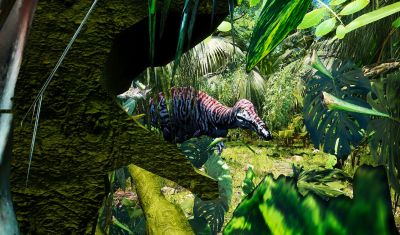Difference between revisions of "Ichthyovenator"
| Line 20: | Line 20: | ||
'''Growth Rate:''' Fast<br> | '''Growth Rate:''' Fast<br> | ||
'''Weather Resistance:''' Average<br> | '''Weather Resistance:''' Average<br> | ||
| − | '''Can be picked up by a tornado: Yes''' | + | '''Can be picked up by a tornado: Yes''' ]] |
=== Overview === | === Overview === | ||
Revision as of 17:15, 25 December 2018

Contents
Paleo Stats
Species: I. laosensisTime Period: Cretaceous
Length: 8.5 meters (27 feet)
Weight: 2 tonnes (2.2 short tons)
Basic Information
Category: CarnivoreDiet: Fish, Meat
In-game Stats (Adult, Growth 1.0)
Health: 625Stamina: 100
Ability: 100
Comfort: 100
Base Food Capacity: 100
Overweight Food Capacity: 130
Water Capacity: 100
Oxygen Capacity: 100
Growth Rate: Fast
Weather Resistance: Average
Can be picked up by a tornado: Yes
Overview
The Ichthyovenator is a playable piscivorous in Beasts of Bermuda. It is a dinosaur that depends heavily on the ocean to keep it alive, as its main food source consists of large quantities fish. For this reason, the Ichthyovenator is capable of swimming at very fast speeds, darting through the water in order to snag as much fish as possible before returning to the shores to rest.
Despite its carnivorous diet and mobility in land and water, it's not as ferocious as one might think. It possesses low health and low damage, so it only poses as a threat to smaller creatures - but its low combat utility is counterbalanced by its incredible elusiveness. The Ichthyovenator is very difficult for any predator to catch, since it can dive into the water when chased by larger terrestrial creatures such as Megalosaurus, and scramble back onto the shoreline when approached by deep-sea threats such as the Kronosaurus. The Ichthyovenator can even slip free from the grab of a Mosasaurus! With so much evasive power, the Ichthyovenator can stay safe even in the most threatening shorelines.
_________________________________________________________
Pros and Cons
Pros:
- Very fast swim speed for a creature that can walk
- Hard to catch
- Can easily sustain its hunger
- Fast growth
Cons:
- Low base health
- Low base damage
_________________________________________________________
Abilities
Primary attack: A simple bite. It inflicts low damage and has a moderate attack speed.
Secondary Attack: Out of the water: A claw swipe, dealing identical damage to its primary attack but with significantly better range, hitting nearby creatures around its sides and belly. In the water: A swift dart through the water, damaging anything the Ichthyovenator rams into. Additionally, the Ichthyovenator will immediately consume fish it makes contact with during the dart.
- Special Ability: Using the Secondary Attack when trapped inside the jaws of a Mosasaurus will allow the Ichthyovenator to struggle out of it, though it costs a high amount of ability power and injures the Ichthyovenator in the process.
Unique Attribute: The Ichthyovenator can detect fish by using its short call (Default button is 2). It will highlight all nearby fish, making them much easier to spot.
_________________________________________________________
Weakness
The Elasmosaurus is rather fragile, having relatively low HP for its size. It also starts the game as a very vulnerable creature, and like all aquatic creatures, it can die from beaching itself.
The Elasmosaurus is also susceptible to being preyed upon by the Mosasaurus and the Kronosaurus. However, The Elasmosaurus is faster and has more stamina than the two, allowing it to dodge their attacks and, if needed, defend itself by retaliating back. Nonetheless, the Elasmosaurus is better off escaping, as one bite from a large predator can be an immediate death sentence for it.
_________________________________________________________
Additional Notes
Other facts: The Ichthyovenator is currently the only semi-aquatic carnivore. This gives it a massive advantage over other carnivores, giving it access to an entirely new food source: fish. Being semi-aquatic also allows the Ichthyovenator to be flexible, able to migrate from land to sea or between islands to evade both land and sea predators. It is rather slow on the land, being a bit slower than the Acrocanthosaurus.